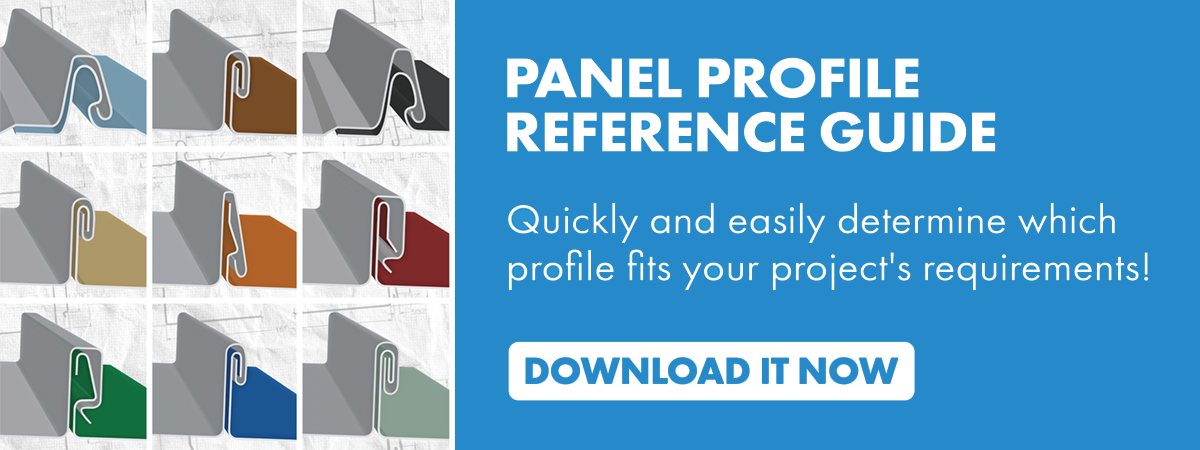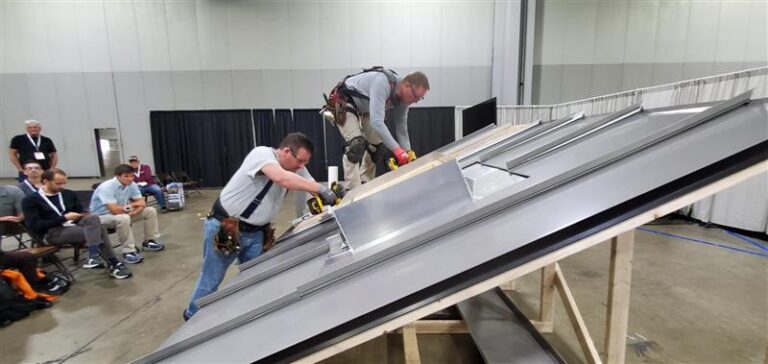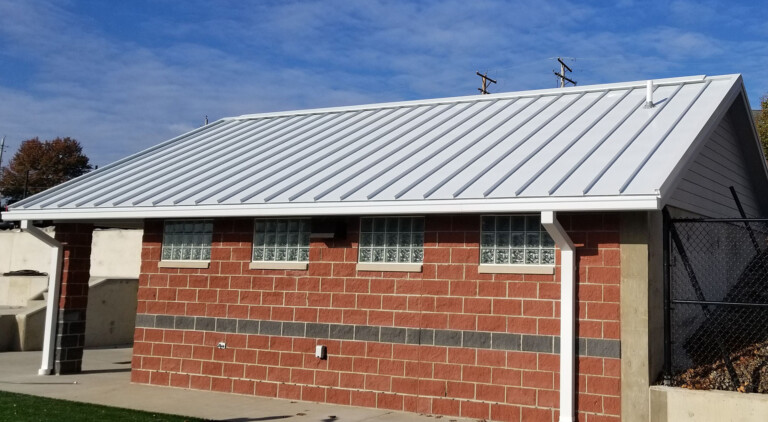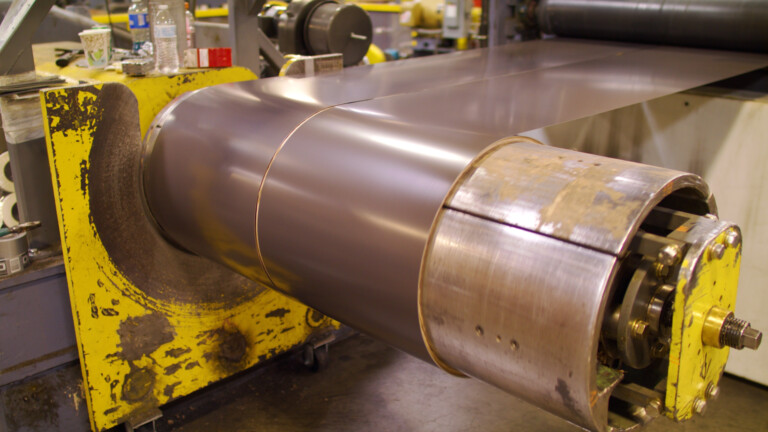What Are Metal Roof Fasteners & Rivets? Types, Definitions, & Cost
Fasteners play a significant role in how a standing seam metal roof will perform, as fasteners are the main anchor points for the metal panels to stay attached to the...
At first glance, you might not think much of a fastener used in a metal roof system. It seems like such a small piece of the puzzle, right?
In reality, fasteners play a significant role in how a standing seam metal roof will perform, as the fasteners are the main anchor points for the metal panels (and clips) to stay attached to the roof deck.
Beyond carrying a full catalog of fasteners and other metal roofing accessories, Sheffield Metals also tests all of our engineered metal roofing systems with specific fasteners to ensure our customers are getting the best products available. We believe it’s essential to become educated on fasteners and how they’re used to protect your metal roof or wall system.

In this article, you can expect to learn:
- What a metal roof fastener is.
- The various types of fasteners.
- The cost of fasteners.
- Some key considerations to remember about fasteners.
What Is a Metal Roofing Fastener?

If you were to look up fastener in a dictionary, you’d get something along the lines of:
A hardware device that mechanically joins or affixes two or more objects together … fasteners are used to create non-permanent joints; that is, joints that can be removed or dismantled without damaging the joining components.
But the term “fastener” is broad and applies to various products in several different industries. For example, the category of fasteners can include such items as:
- Buttons
- Latches
- Pins
- Staples
- Zippers
In this article. we’ll focus on one small sub-section of fasteners used in standing seam metal roof applications. We define these types of fasteners as any type of screw, rivet, or device used to secure metal panels, trim, and flashing materials together or to the roof deck.
Types of Metal Roofing Fasteners
Fasteners are not “one size fits all,” meaning they come in a variety of different types based on the project application. We could spend a lot of time diving into each type, size, and use, but instead, we’re going to keep in simple.
The four main fastener types fit into two categories:
Concealed Fasteners:
- Pancake head fasteners
- Head / Hex head fasteners
Exposed Fasteners:
- Exposed gasket head fasteners
- Rivets / pop rivets
Concealed Fastener Type #1: Pancake Head Fasteners

Description
Pancake head fasteners are the most commonly used fastener in standing seam roofing. These fasteners are attached to the roof deck through the appropriate roofing clip, which is then attached to the panels and secures them to the deck. The head of the fastener sits flat atop the clip like a pancake, hence the name pancake head fastener. Pancake fasteners can be used in trim applications as well.
Size
Pancake head fasteners have a specific sizing system, which looks something like #10-16 x 1½” GP
To someone not in the industry, it might be a little complex, so we’ll break down each element of the fastener type:
- First number (#10): Gauge of the fastener head (diameter)
- Second number (16): Thread count (threads per inch – TPI)
- 13 and below are better suited for wood applications
- 14 and above are better suited for metal applications
- Third number (1½”): Length of the fastener
- Ending letters/descriptor (GP): Screw point type
- GP = Gimlet Point
- DP = Drill Point
- ULP = Ultra-Low Profile
Head/Drive Type
For the most part, pancake head fasteners are split into two categories: regular pancake head and ultra-low profile pancake head. Depending on where you buy your fasteners from, most pancake fasteners will have a Phillips or a square drive type tip.
Fastener Metal Material
Pancake head fasteners are typically made of carbon steel coated in galvanized steel. For saltwater environments where galvanized steel fasteners will corrode quicker, stainless steel pancake head fasteners are available in 302, 304, and 410 stainless.
Roof Deck
Both metal and wood roof decks are suitable for pancake head fasteners.
Concealed Fastener Type #2: Hex Head Fastener

Description
Hex head fasteners are used when attaching metal roofing panels to metal purlins. In open-framing concealed fastener roofing applications, hex head fasteners are installed through a floating clip.
Size
Hex head fasteners follow this sizing structure: ¼”-20 x 1″
- First number (¼”): Diameter of the fastener
- Second number (20): Thread count per inch (TPI)
- Third number (1”): Length of the fastener
Head/Drive Type
As the name alludes to, these fasteners have a hex head drive type.
Fastener Metal Material
Similar to pancake head, hex head fasteners are typically made of carbon steel coated in galvanized steel. For saltwater environments where galvanized steel fasteners will corrode quicker, stainless steel hex head fasteners are available in 302, 304, and 410 stainless.
Additionally, there is a combo option where the shank of the screw is carbon steel, and the exposed head is stainless steel. These are environment-specific and should be verified with the manufacturer based on the application.
Roof Deck
Hex head fasteners are designed for installation in metal substrates; there are hex head fasteners that can even go into ¼” steel. These fasteners are not suitable for wood roof decks.
Exposed Fastener #3: Exposed Gasket Head Fasteners

Description
In exposed fastener metal roofing systems, gasket head fasteners are the most commonly used. When you’re looking at a corrugated or other exposed fastener type of roof, gasket head fasteners are the screws that are drilled through the face of the panels and have the screw head visible.
These screws have a washer/gasket positioned between the head of the screw and the panel that helps to keep water from entering the penetration point.
Size
The sizing structure for gasket head fasteners is pretty simple and looks like this: #10-14 x 2″
- First number (#10): Gauge of the fastener head (diameter)
- In metal roofing applications, #10 and #12 tend to be the most commonly used sizes
- Second number (14): Thread count (threads per inch – TPI)
- Third number (2”): Length of the fastener
Head/Drive Type
Exposed gasket head fasteners typically have a hex drive type.
Fastener Metal Material
Gasket head fasteners come in various metal types, including:
- Carbon steel
- Stainless steel (410 and 304)
- Combo – Carbon steel shank and stainless steel head
- Zinc
Like mentioned earlier, it’s important to use stainless steel fasteners in coastal environments where carbon steel will corrode in a shorter time frame.
Gasket/Washer Material
On top of the metal portion, there is the washer material that works to keep moisture from entering the penetration. Most washers are an EPDM or neoprene material. Some of these screws also have a gasket head steel washer built into the head.
Note: It’s imperative to make sure the washer you’re using does NOT have carbon in it. Some washers are made from old tires, which have steel in them. This steel can create a galvanic reaction that will damage the panels and lead to premature degradation.
Roof Deck
Exposed gasket head fasteners work for metal to wood and some metal to metal applications (dependent on the gauge and tip of the fastener).
Color Options
These fasteners are visible, and that’s why the heads and washers have the option to come painted to match the sheet or coil color of the panels.
Exposed Fastener #4: Rivets / Pop Rivets

Description
Pop rivets or rivets are a little different than the screw-type fasteners discussed above. Rivets are installed by first drilling a hole and then a rivet gun is used to expand and secure the rivet into place. Rivets are most commonly used to connect the flashing to the Z-closure and are prevalent on rake and ridge flashing installation details.
Size
Rivets are smaller compared to the other fasteners and come in a standard size of ⅛”, which is the diameter of the body.
Fastener Metal Material
Rivets are made of stainless steel because they’re exposed to the elements and need to resist rusting and corrosion.
Roof Deck
Rivets are not used for fastening panels to the roof deck and instead are used to connect metal to metal, specifically at flashing points.
Color Options
To help the rivets blend in a little better, you can order them to match the metal roof color. Rivets are also available in a mill finish.
Special Considerations
One of the main concerns regarding rivets is the metal swarf created by drilling a hole in the metal before installing rivets. It’s crucial that you protect the metal to prevent swarf from rusting onto and staining the face of the metal panels.
Cost and Price of Metal Roof Fasteners

The best way for us to explain how much fasteners cost is to give you actual price ranges for the fasteners that we sell.
While these price ranges are good representations of the cost of metal roofing fasteners, prices will still vary depending on:
- The manufacturer of the fastener.
- The application or roof deck substrate (metal vs. wood).
- The substrate of the fastener (carbon steel vs. stainless steel).
- The length of the fastener.
- The diameter of the fastener.
- If the head is painted or not.
- Inflation and market pricing.
Pancake Head Fasteners Price Examples
- 1” Pancake head: $9.00 – $15.00 (per bag of 250)
- 1” Stainless steel pancake head: $28.00 – $35.00 (per bag of 250)
- 1-1/8” Ultra-low pancake head: $9.00 – $15.00 (per bag of 250)
- 1-1/8” Stainless steel ultra-low pancake head: $28.00 – $35.00 (per bag of 250)
Exposed Gasket Head Fasteners Price Examples
- Gasket head: $11.00 – $17.00 (per bag of 250)
- Gasket head stainless steel: $35.00 – $42.00 (per bag of 250)
Pop Rivets / Rivets Price Examples
- Rivets #43: $18.00 – $26.00 (per bag of 250)
Note: At Sheffield Metals, all of our fasteners are priced and sold in individual bags of 250. However, our concealed fasteners (i.e., pancake head) can come in tubs of 5,000 (or 20 bags).
Considerations About Metal Roof Fasteners
Fasteners Testing & Engineering
Fasteners have performance testing and standards to adhere to, which is a key component when deciding which fastener to use based on your project requirements. While these tests will vary depending on the manufacturer, fasteners and the coatings applied to the fastener are often rated for the following:
- Salt spray testing (ASTM B117 Standard Practice for Operating Salt Spray Apparatus)
- Pullout value: Tests how many pounds must be pulling straight up on the fastener for it to pull out from a specific deck type (steel vs. wood).
- Tensile strength: Tests how many pounds can be applied to the fastener until it breaks.
- Torsional value: Tests how many pounds per inch the fastener can rotate until it breaks or fails.
- Shear strength: Tests how many pounds can be pulling down on the fastener until the head rips off.
On top of the tests for individual fasteners, the fasteners used in a metal roofing system are also part of an engineered assembly or profile. While a lot of the testing applies to the spacing of the clips for panel attachment, it also includes the sizing, type, and quantity of fasteners used in the system.
Required Tools
For pancake head, hex head, and exposed gasket head fasteners, it’s recommended that you install it using a screw gun with adjustable torque settings with appropriate drive (hex, square, etc.).

For rivets, a rivet gun (like the one above) is needed to install properly.
Installation Details & Weathertight Warranty Requirements
One final note we want to discuss is how fasteners are used in installation details and how it correlates to weathertight warranties (commercial projects only). Installation details are the in-depth product guide detailing the location and basic practical installation methods for components and accessories, including fasteners. In general, following the installation details are a best practice, especially if you want the roof to last and perform to high standards.
In essence, installation details will give you detailed instructions for fastener uses, including the type of fastener, the spacing, and the quantity needed.
To receive a weathertight warranty, it’s required that these installation details are followed. This is why you should know and use them for all of your metal roofing projects, especially ones that include a weathertight warranty.
Final Thoughts on Metal Roof Fasteners
As you can tell, fasteners are a vital part of a standing seam metal roofing system, and it would be impossible to have a functioning roof without these components.
Remember, metal roofing fasteners and rivets comprise a small subsection of fasteners overall, but there are four general categories that you’re likely to come across. Here’s a quick recap:
- Pancake head fasteners – Used for concealed fastener roof systems to attach the clips (and therefore the panels) to the roof deck.
- Hex head fasteners – Used for concealed fastener roof systems to attach floating clips to metal purlins in an open framing application.
- Exposed gasket head fasteners – Used in exposed fastener roof systems to attach metal panels directly to the roof deck through the panel’s surface.
- Pop rivets – Used to attach metal to metal at flashing points.
Sheffield Metals has spent over 25 years building a product line designed for architecturally-driven metal roofing and wall projects — including fasteners like those described in this article. We’ve partnered with reputable manufacturers like Triangle Fastener Corporation to provide high-quality fasteners for nearly any roof or wall application.
Contact us today to discuss your fastener questions with one of our knowledgeable metal roofing specialists!





